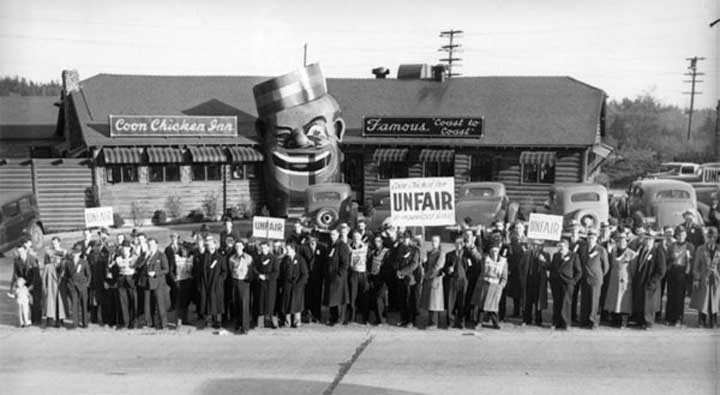The term coon emerged in early America as a shortening of raccoon and, according to the Oxford English Dictionary, soon became synonymous with “a sly, knowing fellow,” and, subsequently, “a Negro.” Though originally associated with white ‘backcountry folk’, the shift in the use of coon from an expression describing a country rube to a derogatory term for an African-American is connected to the introduction and instant success of the 19th century minstrel show character Zip Coon. Though not the first blackface character in the minstrel tradition, according to cultural critic John Strausbaugh, Zip Coon became the first popular minstrel personality to represent the “black urban dandy… a ‘negar’ who ‘acts white. For whites who feared job competition once slavery ended, the Zip character served as a symbol of “the terror that lower-class whites had of being left at the bottom if ‘niggars’ like Zip got too uppity.”. On stage, Zip Coon would act like a braggart and a fool, eliciting laughter and fascination while reinforcing white supremacy and hostility toward African-Americans.
In the late 19th century, the Coon caricature was revised to fit the predilections of post-Civil War whites who, according to historian Kenneth Goings, were not prepared to “handle the status of African-Americans as free and technically equal.” The Coon caricature became a way for both northerners and southerners to relive a nostalgic memory of the Old South, one where black slaves were cared for by benevolent white masters and in which African-American males loved to sing, dance, and steal chickens. The origin of this chicken-thieving stereotype is unclear, but is likely rooted in 18th and 19th century narratives and images and in the fact that slaves often did steal chickens and livestock from masters as a form of protest or to augment their meager food rations. After emancipation, the inclusion of such stereotypes and caricatures of African-Americans in collectibles and advertising became an effective way for whites to reinforce the myth of the Old South in the collective national memory.

Coon Chicken Inn with delivery vehicle in the foreground. Restaurant patrons would enter through the mouth of the large “Coon” head pictured here. Image courtesy of the Shoreline Historical Museum.

Coon Chicken Inn also encountered resistance from organized labor. Citing unfair labor practices but ignoring the restaurant’s racist name and logo, in March 1937 the Bartenders, Cooks. Waiters and Waitresses Union picketed outside CCI for a week before reaching an settlement. Courtesy of the Museum of History and Industry.

an open menu.

A Coon Chicken Inn matchbook. Notice the color of the face above. CCI changed the skin tone from brown to blue in an effort to evade an NAACP lawsuit filed in 1930. Courtesy of the

“Chicken Inn Dodges Suit with Blue Paint: Threatened with prosecution by the Seattle NAACP who charged them with advertising defamatory to colored people the ‘CCI’ is avoiding the charge by changing the black background of their advertising to blue… Miss Codetis Thiel, assistant prosecutor held the owners of the chicken inn were subject to prosecution if they used a black face labeled ‘coon’ in their advertising. The Company has now dodged prosecution by using a blue color in their advertising and [removing] the word ‘coon’ from the teeth of the man’s mouth”

In September of 1930, the NAACP filed a lawsuit against Coon Chicken Inn claiming the restaurant’s name and iconography amounted to “libel and defamation of a race.” The major newspapers ignored the suit, but the story was covered in the Northwest Enterprise, a local African-American-owned paper.
Coon Chicken Inn matches: the long history of lynching, which often included the burning of African American victims, adds a disturbing subtext to this artifact.
 The CCI was able to “dodge” the suit by changing the color of its logo from brown to blue. Nevertheless, the NAACP’s lawsuit was an important demonstration of African American agency.
The CCI was able to “dodge” the suit by changing the color of its logo from brown to blue. Nevertheless, the NAACP’s lawsuit was an important demonstration of African American agency.
Seattle was a segregated city for most of the 20th century, and the popularity of the Coon Chicken Inn must be understood in this context. Restrictive covenants such as this one from the Innis Arden neighborhood were widespread throughout the city. Many are still on the books despite recent legislation that makes it easier for homeowner’s associations to eliminate them. For more on restrictive covenants and racial segregation in Seattle

A portrait of CCI founder Maxon Lester Graham on the cover of a trade publication from July, 1942. Graham had just been elected president of the Washington State Restaurant Association.

No comments:
Post a Comment